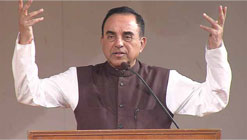
In 2014 Elections, the then candidate for Prime Minister, Narendra Modi, had asked the party to set up a committee on strategic action for the elections. I was selected as the chairman. We had recommended, amongst the many measures for fighting black money-demonetisation of a part of the currency. Two and a half years later or more, demonetisation was taken as a strategic objective. And the Prime Minister on the night of 8th November 2016, announced that by midnight, Rs. 500 note and Rs. 1000 notes will become, what he called ‘useless pieces of paper’.
A successful policy has four components. The objective, the priority or the priorities, the strategy to achieve those objectives according to those priorities and, the necessary machinery and resources to execute that strategy. Demonetisation of Rs. 1000 and Rs.500 notes was a strategy to eliminate the black money. How much it has affected black money is one of the questions we are asking today and I answer that. But let me say that demonetisation is a small part of the strategy for eliminating black money. For eliminating black money, we have to actually take many other kind of measures.
This demonetisation was focused on the stock of black money held by people-which is unaccounted money generated by avoiding paying taxes by false accounting, by under invoicing and over invoicing exports and imports, by deliberately undervaluing the value of a property so that you don't have to pay the tax at a valuation. So there are many ways by which you avoid paying taxes, and that avoidance of tax is actually an evasion and that amount is black money. It's also used to elicit illegal operations, purchases and sale of narcotics, prostitution, spending in elections and bribing of voters. Therefore, black money is quantum of money which is not disclosed to anybody and it is placed in secret transaction, where the giver and taker participate in it.
Now what happens, when I have back money, and I go in a taxi and the taxi fare is paid by me out of that black money in my pocket? The taxi driver has legitimately earned that money. So the black money in my pocket suddenly becomes white money in his pocket. Therefore, the black money is sometimes black, sometimes white, depending on how it is used.
A successful policy has four components. The objective, the priority or the priorities, the strategy to achieve those objectives according to those priorities and, the necessary machinery and resources to execute that strategy. Demonetisation of Rs. 1000 and Rs. 500 notes was a strategy to eliminate the black money. How much it has affected black money is one of the questions we are asking today
Black money within a country is not a stock, per say. And that is why we measure black money in terms of transactions. What proportion of the total transactions in the country is outside the auditing system or accounting system? It is roughly estimated that 40 per cent of our GDP, which represents the net transaction in the country in a year is black.

So to tackle that, you need various instruments. The most efficient instrument is to change the economic system so that you do not have an incentive to avoid paying taxes. For instance, in 1991, when Narsimha Rao, and before that Chandra Shekhar, were Prime Ministers, and I held a ministerial ranked position in both, as senior most minister, this problem of black money was tackled by simplifying the system. We abolished quota and licenses.
The worst part is that my committee in 2014, had recommended that once we demonetise, which we are in favour of, we must be sure that the compensating increase in the currency of other denomination is already in place. We had recommended six times more Rs. 100 notes than before and estimated that it would take about two years to print that. A new Rs. 200 note also to be brought into circulation. All of the same size, not smaller size-otherwise there would have been problem to fit them in ATMs, like there is now for Rs. 2000. So, first of all, what turns out is, demonetisation, did not have such preparation.
The Prime Minister, on 7th November, by letter through his office, had informed the Reserve Bank saying he proposes to do this and we want immediate action to he initiated. Two senior secretaries of Finance Ministry were members of the Board. So to say that the Finance Ministry was not in the loop, isn't correct. The Board ought to have told the Prime Minister that we have not printed extra notes of Rs.100. We were planning to bring out Rs. 2000 note anyway. They perhaps did not say it was going to be of smaller size and there would be a problem of fitting it in the ATMs. Instead, they told the Prime Minister to go ahead. ‘We will move into it and people will be thrilled etc.’ And that lack of preparation is the only reason why this desirable measure has not worked the way we wanted it to work.
Demonetisation was supposed to eliminate black money. Has it eliminated black money? To some extent! We have put the terrorists out of action, because they were dealing with counterfeit notes. The reason Pakistan could easily counterfeit notes is that India does not produce its own currency paper. We import it from abroad. And, the former Finance Minister gave the contract to a company called De La Rue in London to print currency paper which would be then be placed in Nashik Press and other presses to print notes. Our agencies like the RAW, IB, CBI opposed this saying De La Rue also prints currency for Pakistan. It would be easy for Pakistan to give money to that private company and get Indian currency paper, which they can then print in their country and make it very difficult to detect counterfeit currency.
The Board ought to have told the Prime Minister that we have not printed any extra notes of Rs. 100. We were planning to bring out Rs. 2000 note anyway. They perhaps did not say it was going to be a smaller size and had a problem of fitting it in the ATMs. Instead, they told the Prime Minister of course go ahead, we will move into it and people will be thrilled
Now suddenly this currency had become illegal and so, after November 8, there has not been stone throwing in Kashmir. But that's not good enough; we want to eliminate black money, has it been eliminated? At least 10 per cent, 20 per cent eliminated? I asked my friends in the Reserve Bank, how much currency has come back? People were putting money and getting new notes. It turns out that almost 100 per cent of the old currency has come back. How can 100 per cent come back?

What had happened is that, because there was no currency, if I had Rs. 10,000 in black money and I gave a tout or a corrupt bank manager 25 per cent of that, which comes to Rs. 2,500, he gave me the remaining Rs. 7,500 in the form of new notes of Rs. 2000 and Rs. 500 which have now come. So, previously I had Rs.10,000 and now I have Rs. 7,500. It is black because it's unaccounted. But it is in new notes. And the bank officer and the tout have become richer by Rs. 2,500. All that has happened after demonetisation is that the amount of black money in the Indian economy is still the same, except that bank officers and touts have become richer by getting 25 per cent. The black money holder had new black money notes but at 75 per cent of what he had before. Only a redistribution of the money has taken place. So also, now it turns out that the terrorists in Kashmir too have used this route. They lost 25 per cent of their money in the process, but got in place of their counterfeit note the genuine Indian notes for 75 per cent of the total amount they had, initially. Therefore I'll have to say, this present demonetisation has not worked. It has not achieved its objective. But that doesn't mean that the present demonetisation is a bad measure. It was badly planned in the sense there was no planning. Every ministry normally has to have a contingency plan even if you have not been asked.
When in 2014, it was decided that we will fight black money and one of the measures will be demonetisation, the Finance Ministry ought to have prepared a contingency plan. But it did not prepare the contingency plan. I don't know the reasons why.
So, why is it this important for us to fight black money in the first place? I had, in fact, suggested after seeing the long queues that why we don’t do this that anybody, who has cash of any amount, can deposit it in his bank account. No questions asked. But 25 per cent of that will be taken by the government. You can withdraw 25 per cent in cash in the form of new notes. And you leave 50 per cent you in the bank as fixed deposit for five years at two per cent interest. The proposal was sent to Finance Ministry. What came out was that the government would take 50 per cent, not 25 per cent. And 25 per cent would be put in fixed deposit at zero per cent interest and 25 per cent you can withdraw. Nobody came forward. Who is going to give 50 per cent to the government when the tout is giving you for 25 per cent? Somebody said this is legitimate. I said it is not legitimate in the sense that I have to put my name in the register-the future government can track me and chase me. So everybody will be insecure. Therefore, we will continue to give the money to bank’s corrupt official and the tout for 25 per cent. And the remaining 75 per cent is now in brand new notes, no fixed deposit, nothing.
Indians respond very well to crisis. I think we should have one crisis, every 10 years. So that we benefit. So this is nothing very bad for us that we can’t recover. There are many changes that are necessary because of the approach; those who are not responsible for making the contingency plan, they should be punished. Who they are, it’s the Prime Minister who has to decide. But to think the idea was necessary
Even today, we can retrieve the situation. The damage done today is not so much. You stood in a line and you were harassed. You timed it such, that it coincided with the wedding season and hurt a lot of people in arranging marriages. But it was the collateral damage of that move-unprepared move.
For example, Bihar migrant workers used to come every year to Punjab. They were paid in cash. There was no cash to pay, therefore they went back home. They are sitting at home in Bihar, discontented. Same happened in Tamil Nadu. Lots of Biharis go there in the rice season, but they have all come back. One truck owner told me, “I have cut down the number of trucks I'm sending by 50 per cent because each driver has to be given money for eating food in dhaba, for paying for the petrol and perhaps a bribe here or there. I don't have cash or small currency. I couldn't say here is Rs. 2000, go eat in a dhaba and get me change. No dhaba would give him change. Because he himself doesn't have it.”
Small and medium industry, which relied heavily on daily wage workers had to shut down. This kind of damage is done. There is real estate sector, which was literally running on black money, without any alternative arrangement. It has come down to 30 per cent. Automobile purchases, which large number of people used to buy with cash, although illegal, had boosted up the automobile industry. That has also slumped. So, it has done a huge damaging effect in the economy. But I repeat again, it is rectifiable. India has seen many a crisis and come out much stronger.
Today we are a much stronger economy because of the crisis. I think, Indians respond very well to crisis. I think we should have one crisis, every ten years so that we benefit. So, this is nothing very bad for us that we can't recover. There are many changes that are necessary because of the approach. Those who are responsible for making the contingency plan, should be punished. Who they are? It's for the Prime Minister to decide. But to think the idea was necessary. The time was about right, but we did not do it. Let me say, this is a small measure to fight black money.
by Dr Subramaniam Swamy